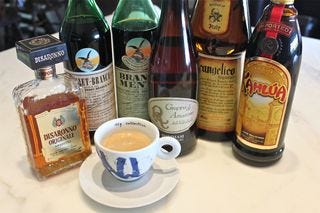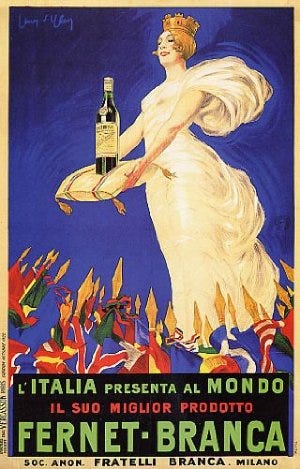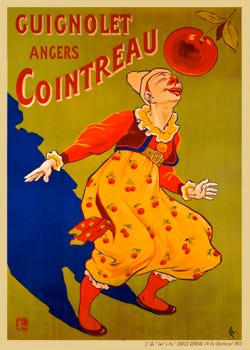The Best Way to End a Large Dinner – Espresso Corretto

Rich desserts, cheese platters and decaffeinated coffee at the end of a big dinner are so… 2009.
Of all the ways to end a grande bouffe, the item, which I have long been compelled to order, is a “fortified espresso.” The beverage is called “caffe corretto” in Italy, where the concoction originated.

“Caffe corretto,” also called “espresso corretto,” simply means a “corrected” coffee. It’s a thimbleshot of espresso to which one adds a tablespoon, or more, of grappa, a digestive, or a flavored liqueur. It makes the coffee experience slightly sweeter and the “digestif” helps process all that food you’ve wolfed down.

Bitters such as Fernet-Branca, Branca-Menta, or Cynar, lesser known Italian digestive drinks, or popular liqueurs, can help settle your stomach after a big meal; the alcohol is a nice end-cap to dinner, and helps the flavor of the espresso linger. That’s a win-win-win in my gastronomic world.
Nash Cognetti, executive chef at Tra Vigne, in St. Helena, Napa Valley, agrees that it’s time to shine a spotlight on “corretto.” He’s recently put “espresso corretto” on his dessert menu: a shot of Illy café with a 1.5-ounce serving of your choice of rocket fuel – grappa, Fernet-Branca, Branca-Menta, or Sambuca.

Caffe corretto is thought to have originated in Naples, according to a food blogger named Barbara, who lives in that city and who writes colorfully about her Neapolitan life at http://theespressobreak.blogspot.com/2010/01/caffe-corretto.html
“The tradition of correcting coffee with alcohol very likely started in the 1800's during a time when coffee became an ubiquitous beverage in Naples thanks to the caffettiere ambulante or wandering coffee peddlers. These men yelled out to customers in the early morning hours: "Vulite na tazzuella di caffe?" They wore aprons and set up tables along the street replete with small burners, cups, saucers, sugar, and a bottle of rum.” Barbara continues:
“Today, at ten in the morning, I see quite a few men drinking caffe corretto before heading off to work. The portions are so small that the caffe has a bite, but not much more.”
Italians mostly infuse their ”caffe corretto” with grappa, Sambuca, or digestive liqueurs like Fernet-Branca.

Americans sometimes turn to whiskey, brandy, Baileys Irish Cream, Kalhua, or Scotch for blending purposes.
But the idea is to add just enough liqueur to the hot, concentrated, just-made espresso to fortify it, and give it a spine of flavor. You should still taste coffee in an espresso corretto; if you don’t, you have added too much liqueur.

Puzzled at how I might illustrate this short piece on espresso corretto, I had my “Eureka!” moment walking down a street in Seattle, WA, last month. In the window of a fabulous vintage poster shop was a dramatic, original poster for a carbonated Italian digestive called Chinotto.

I asked Michael Maslan, owner of Vintage Posters, if I might take photos of the vintage posters relating to my theme. He was plenty friendly, like everyone I met in Seattle, and pulled out several posters.

If anyone is looking for original posters on travel themes, Michael is a source. Contact him at oldphoto4u@aol.com. His store is at 109 University St., Seattle, WA, 98101. Phone 206-587-0187. Don’t be surprised if the store is closed when you drop by; better to make an appointment by phone. As the sign says in the window: Hours by Chance or Appointment.
If anyone is looking for an espresso corretto, head to your nearest Italian sports bar, Ital-taverna, or the next time you are in St. Helena, mosey up to the bar at Tra Vigne and ask Eileen to make you one.

